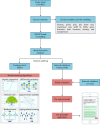An artificial intelligence application to predict prolonged dependence on mechanical ventilation among patients with critical orthopaedic trauma: an establishment and validation study
- PMID: 39736687
- PMCID: PMC11684237
- DOI: 10.1186/s12891-024-08245-9
An artificial intelligence application to predict prolonged dependence on mechanical ventilation among patients with critical orthopaedic trauma: an establishment and validation study
Abstract
Background: Prolonged dependence on mechanical ventilation is a common occurrence in clinical ICU patients and presents significant challenges for patient care and resource allocation. Predicting prolonged dependence on mechanical ventilation is crucial for improving patient outcomes, preventing ventilator-associated complications, and guiding targeted clinical interventions. However, specific tools for predicting prolonged mechanical ventilation among ICU patients, particularly those with critical orthopaedic trauma, are currently lacking. The purpose of the study was to establish and validate an artificial intelligence (AI) platform to assess the prolonged dependence on mechanical ventilation among patients with critical orthopaedic trauma.
Methods: This study analyzed 1400 patients with critical orthopaedic trauma who received mechanical ventilation, and the prolonged dependence on mechanical ventilation was defined as not weaning from mechanical ventilation for ≧ 7 days. Patients were randomly classified into a training cohort and a validation cohort based on the ratio of 8:2. Patients in the training cohort were used to establish models using machine learning techniques, including logistic regression (LR), extreme gradient boosting machine (eXGBM), decision tree (DT), random forest (RF), support vector machine (SVM), and light gradient boosting machine (LightGBM), whereas patients in the validation cohort were used to validate these models. The prediction performance of these models was evaluated using discrimination and calibration. A scoring system was used to comprehensively assess and compare the prediction performance of the models, based on ten evaluation metrics. External validation of the model was performed in 122 patients with critical orthopaedic trauma from a university teaching hospital. Furthermore, the optimal model was deployed as an AI calculator, which was accessible online, to assess the risk of prolonged dependence on mechanical ventilation.
Results: Among the developed models, the eXGBM model had the highest score of 50, followed by the LightGBM model (48) and the RF model (37). In detail, the eXGBM model outperformed other models in terms of recall (0.892), Brier score (0.088), log loss (0.291), and calibration slope (0.999), and the model was the second best in terms of area under the curve value (0.949, 95%: 0.933-0.961), accuracy (0.871), F1 score (0.873), and discrimination slope (0.647). The SHAP revealed that the most important five features were respiratory rate, lower limb fracture, glucose, PaO2, and PaCO2. External validation of the eXGBM model also demonstrated favorable prediction performance, with an AUC value of 0.893 (95%CI: 0.819-0.967). The eXGBM model was successfully deployed as an AI platform, which was at https://prolongedmechanicalventilation-lqsfm6ecky6dpd4ybkvohu.streamlit.app/ . By simply clicking the link and inputting features, users were able to obtain the risk of experiencing prolonged dependence on mechanical ventilation for individuals. Based on the risk of prolonged dependence on mechanical ventilation, patients were stratified into the high-risk or the low-risk groups, and corresponding therapeutic interventions were recommended, accordingly.
Conclusions: The AI model shows potential as a valuable tool for stratifying patients with a high risk of prolonged dependence on mechanical ventilation. The AI model may offer a promising approach for optimizing patient care and resource allocation in critical care settings.
Clinical trial number: Not applicable.
Keywords: A comprehensive evaluation system; Artificial intelligence; Critical orthopaedic trauma; Machine learning; Mechanical ventilation.
© 2024. The Author(s).
Conflict of interest statement
Declarations. Ethics approval and consent to participate: The use of the MIMIC-III database was approved by the Institutional Review Board of Beth Israel Deaconess Medical Center (32128436). Since the data in the MIMIC-III database has been de-identified, patient consent was not required. External validation of the model was performed in 122 patients with critical orthopaedic trauma from a university teaching hospital, and the Ethics Committee of our hospital approved the study. We commit to strictly adhere to ethical guidelines and legal regulations at all stages of the research and ensure the appropriate use and protection of patient privacy. Consent for publication: Not applicable. Competing interests: The authors declare no competing interests.
Figures






Similar articles
-
Development and validation of an artificial intelligence mobile application for predicting 30-day mortality in critically ill patients with orthopaedic trauma.Int J Med Inform. 2024 Apr;184:105383. doi: 10.1016/j.ijmedinf.2024.105383. Epub 2024 Feb 17. Int J Med Inform. 2024. PMID: 38387198 Clinical Trial.
-
Establishment and validation of an interactive artificial intelligence platform to predict postoperative ambulatory status for patients with metastatic spinal disease: a multicenter analysis.Int J Surg. 2024 May 1;110(5):2738-2756. doi: 10.1097/JS9.0000000000001169. Int J Surg. 2024. PMID: 38376838 Free PMC article.
-
CHRONIC CRITICAL ILLNESS IN BONE TRAUMA PATIENTS: AN AI-BASED APPROACH FOR INTENSIVE CARE UNIT HEALTHCARE PROVIDERS.Shock. 2025 Jul 1;64(1):27-37. doi: 10.1097/SHK.0000000000002549. Shock. 2025. PMID: 39965586
-
Artificial intelligence in clinical care amidst COVID-19 pandemic: A systematic review.Comput Struct Biotechnol J. 2021;19:2833-2850. doi: 10.1016/j.csbj.2021.05.010. Epub 2021 May 7. Comput Struct Biotechnol J. 2021. PMID: 34025952 Free PMC article. Review.
-
The CMLA score: A novel tool for early prediction of renal replacement therapy in patients with cardiogenic shock.Curr Probl Cardiol. 2024 Dec;49(12):102870. doi: 10.1016/j.cpcardiol.2024.102870. Epub 2024 Sep 27. Curr Probl Cardiol. 2024. PMID: 39343053 Review.
Cited by
-
Artificial Intelligence in Primary Care Decision-Making: Survey of Healthcare Professionals in Saudi Arabia.Cureus. 2025 Apr 9;17(4):e81960. doi: 10.7759/cureus.81960. eCollection 2025 Apr. Cureus. 2025. PMID: 40351962 Free PMC article.
References
-
- Ratti LSR, Tonella RM, Figueir≖do LCd, Saad IAB, Falcão ALE. Oliveira PPMd: Inspiratory Muscle Training Strategies in Tracheostomized critically ill individuals. Respir Care. 2022;67(8):939–48. - PubMed
Publication types
MeSH terms
LinkOut - more resources
Full Text Sources

